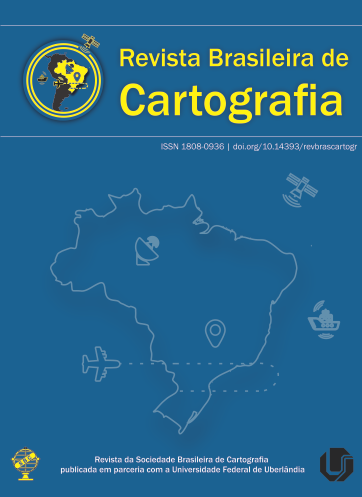Avaliação da Acurácia Posicional do Mosaico Sentinel-2 para Análise de Aplicabilidade na Atualização da Base Cartográfica Contínua na escala 1:100.000 (BC100)
Conteúdo do artigo principal
Resumo
A disponibilidade de geotecnologias tem estimulado a produção e o consumo de informações espaciais, aumentando a necessidade de validações para garantir a qualidade cartográfica. Este artigo tem como objetivo avaliar a aplicação de imagens do satélite Sentinel-2, que podem ser obtidas sem custos e em forma de mosaico temporal pela plataforma Google Earth Engine (GEE), para atualização da Base Cartográfica Contínua na escala de 1:100.000 (BC100) do Instituto Brasileiro de Geografia e Estatística (IBGE). Foi avaliada a acurácia posicional planimétrica, tomando como referência um ortomosaico do IBGE, com resolução espacial de 1 m, utilizou-se o método de feições lineares Buffer Duplo. Foram analisadas as vias da Universidade Federal Rural do Rio de Janeiro (UFRRJ), campus Seropédica, as quais foram vetorizadas na imagem de referência e no mosaico em teste. Em seguida foram avaliadas as discrepâncias obtidas, considerando o Padrão de Exatidão Cartográfica para Produtos Cartográficos Digitais (PEC-PCD) e o Erro Padrão (EP), para escala 1:100.000, obteve-se como resultado classe A. A aprovação do mosaico temporal formado por pixels de dias diferentes, disponibilizado pelo GEE, motivou a validação dos arquivos brutos e do mosaico obtido pela plataforma Sentinel Hub (EO Browser), ambos formados por pixels do mesmo dia. Aplicou-se a Análise de Variância (ANOVA) para comparar as discrepâncias entre as imagens e concluiu-se que estatisticamente não há diferenças. Mostrando que para a área de estudo, analisando as vias, as imagens brutas do Sentinel-2, o mosaico temporal GEE e mosaico Sentinel Hub são aplicáveis para a atualização da BC100.
Downloads
Detalhes do artigo
Seção
Autores que publicam nesta revista concordam com os seguintes termos:
- Autores mantém os direitos autorais e concedem à revista o direito de primeira publicação, com o trabalho simultaneamente licenciado sob a Licença Creative Commons Atribuição que permite o compartilhamento do trabalho com reconhecimento da autoria e publicação inicial nesta revista.
- Autores têm autorização para assumir contratos adicionais separadamente, para distribuição não-exclusiva da versão do trabalho publicada nesta revista (ex.: publicar em repositório institucional ou como capítulo de livro), com reconhecimento de autoria e publicação inicial nesta revista.
- Autores têm permissão e são estimulados a publicar e distribuir seu trabalho online (ex.: em repositórios institucionais ou na sua página pessoal) a qualquer ponto antes ou durante o processo editorial, já que isso pode gerar alterações produtivas, bem como aumentar o impacto e a citação do trabalho publicado (veja "O Efeito do Acesso Aberto").





